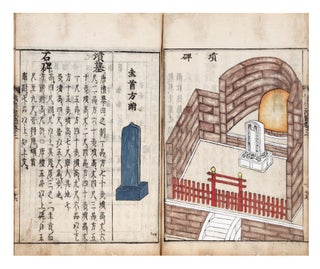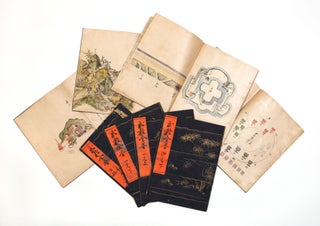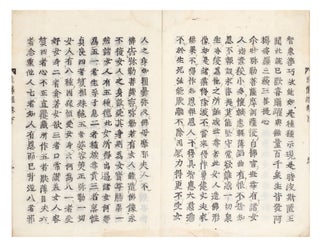The Beginning of the Banking System in Japan
Manuscript, entitled at beginning of text “Gyoyoshu” [“Collection of Details on Rice Brokers’ Money Lending”].
101; 100; 100 folding leaves. Three vols. Oblong 8vo (155 x 217 mm.), orig. wrappers, new stitching. [Japan]: Preface dated 1818.
The rice brokers of Japan during the Edo period became fabulously wealthy, not so much from dealing in rice but from money lending. In Edo in 1724, 109 rice brokers formed a powerful guild known as fudasashi (note/bill exchange), located in the Asakusa section of what is today Tokyo, close to the warehouses where the brokers stored rice produced by the farmers of various daimyos. The fudasashi stored rice for a fee, lent money at high interest rates to the increasingly poor daimyo (most daimyo were ignorant of financial matters and, while prices continued to rise, feudal revenues were fixed), arranged the daimyos’ tax payments to the shogunate, and managed the sale, on a commission basis, and transportation of rice around the country. Their lending activities, along with those of their colleagues in Osaka, developed into what we know today as banks.
“The fudasashi as a class made outrageous profits and were notorious for their patronage of the most luxurious establishments in the pleasure quarters of Yedo. They were the most prominent and the most numerous of the great spendthrifts of the day. The wealthiest among them were those who advanced money to the Shogun’s direct retainers, the hatamoto and the go-kenin, on the security of their rice stipends. These brokers drove a hard bargain.”–George Sansom, A History of Japan, 1615-1867, p. 196.
Due to their great wealth and increased social stature, the fudasashi had a very uneasy relationship with the shogunate.
The present work was written by Sadatsugu Ogiya, a member of the fudasashi guild. His intention was to provide a unique and highly detailed inside view of the workings of the guild. The first volume contains details of the original 109 members and their clients. We also find copies of official correspondence between the bugyo and guild members. There are also discussions of interest rates, records of volumes of rice sold each year, changing regulations, the internal organization of the guild, etc.
Volume II gives a very detailed account of the transactions and day-to-day problems within the guild from 1795 to 1818. There are accounts of attempted (and successful) bribery; fraudulent activities; relations between the rice brokers of Kyoto, Osaka, and Edo; business successes and failures; matters of transportation of rice; the numerous conflicts with the shogunate regarding rice prices, interest rates, and lending terms; etc., all based on archival records.
The third volume offers details on wages for the warehouse workers, further details on the members of the fudasashi, trade names, notable events (nearly on a daily basis), correspondence between members, membership fees, membership lists with rankings of importance, information on succession of members, terms of loan payments (with details of collection efforts), etc.
A nice set, preserved in a chitsu. Some considerable worming to the wrappers, all carefully mended. There is also some worming to the text, but it has been skillfully repaired and we do not find it offensive. An inscription on the back of each volume states that a “Mr. Hara” owned this manuscript.
Price: $13,500.00
Item ID: 8455

![Item ID: 8455 Manuscript, entitled at beginning of text “Gyoyoshu” [“Collection of Details on Rice Brokers’ Money Lending”]. Sadatsugu OGIYA, not Sadayoshi.](https://jonathanahill.cdn.bibliopolis.com/pictures/8455.jpg?width=768&height=1000&fit=bounds&auto=webp&v=1664394285)
![Manuscript, entitled at beginning of text “Gyoyoshu” [“Collection of Details on Rice Brokers’ Money Lending”].](https://jonathanahill.cdn.bibliopolis.com/pictures/8455_2.jpg?width=320&height=427&fit=bounds&auto=webp&v=1664394285)
![Manuscript, entitled at beginning of text “Gyoyoshu” [“Collection of Details on Rice Brokers’ Money Lending”].](https://jonathanahill.cdn.bibliopolis.com/pictures/8455_3.jpg?width=320&height=427&fit=bounds&auto=webp&v=1664394285)
![Manuscript, entitled at beginning of text “Gyoyoshu” [“Collection of Details on Rice Brokers’ Money Lending”].](https://jonathanahill.cdn.bibliopolis.com/pictures/8455_4.jpg?width=320&height=427&fit=bounds&auto=webp&v=1664394285)
![Manuscript, entitled at beginning of text “Gyoyoshu” [“Collection of Details on Rice Brokers’ Money Lending”].](https://jonathanahill.cdn.bibliopolis.com/pictures/8455_5.jpg?width=320&height=427&fit=bounds&auto=webp&v=1664394285)
![Manuscript, entitled at beginning of text “Gyoyoshu” [“Collection of Details on Rice Brokers’ Money Lending”].](https://jonathanahill.cdn.bibliopolis.com/pictures/8455_6.jpg?width=320&height=427&fit=bounds&auto=webp&v=1664394285)



